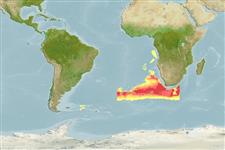Environment: milieu / climate zone / depth range / distribution range
Ecologia
marino batipelagico; distribuzione batimetrica 2000 - 2200 m (Ref. 6593). Deep-water
Atlantic Ocean: in 2018, known from 6 adults (Atlantic Ocean), and 2 larvae (Sargasso Sea).
Size / Peso / Age
Maturity: Lm ? range ? - ? cm
Max length : 16.0 cm TL maschio/sesso non determinato; (Ref. 6593)
Short description
Chiavi di identificazione | Morfologia | Morfometria
Body somewhat arrow-shaped and bright red in color (Ref. 6593).
Life cycle and mating behavior
Maturità | Riproduzione | Deposizione | Uova | Fecundity | Larve
Castle, P.H.J., 1986. Cyemidae. p. 192-193. In M.M. Smith and P.C. Heemstra (eds.) Smiths' sea fishes. Springer-Verlag, Berlin. (Ref. 6593)
IUCN Red List Status (Ref. 130435: Version 2024-1)
Threat to humans
Harmless
Human uses
Pesca: di nessun interesse
Strumenti
Special reports
Download XML
Fonti Internet
Estimates based on models
Preferred temperature (Ref.
123201): 1.7 - 2.5, mean 1.8 °C (based on 3 cells).
Phylogenetic diversity index (Ref.
82804): PD
50 = 1.2500 [Uniqueness, from 0.5 = low to 2.0 = high].
Bayesian length-weight: a=0.00102 (0.00046 - 0.00225), b=3.06 (2.88 - 3.24), in cm total length, based on all LWR estimates for this body shape (Ref.
93245).
Trophic level (Ref.
69278): 3.6 ±0.5 se; based on size and trophs of closest relatives
Resilienza (Ref.
120179): Medio, tempo minimo di raddoppiamento della popolazione 1.4 - 4.4 anni (Assuming tmax>3).
Fishing Vulnerability (Ref.
59153): Low vulnerability (10 of 100).
